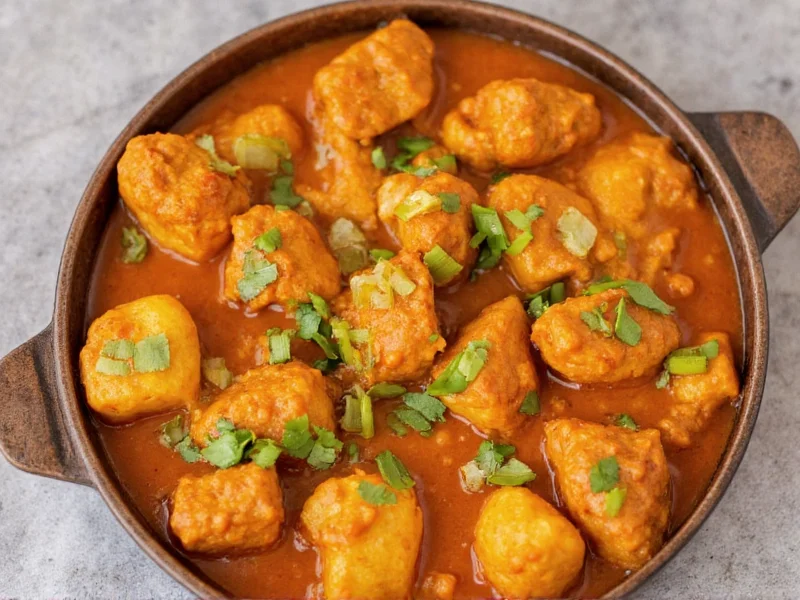Tikka masala represents one of the most successful culinary exports from the Indian subcontinent, captivating palates across the globe with its perfect balance of smoky, creamy, and aromatic flavors. The dish's journey from regional specialty to international phenomenon reveals fascinating cultural intersections in food history.
Origins and Historical Development
While often considered a traditional Indian dish, tikka masala's history reveals a more complex story. Food historians generally agree that modern tikka masala likely developed in the mid-20th century, with strong evidence pointing to its creation in either India or by South Asian immigrants in the United Kingdom. The dish appears to have evolved from traditional Indian tandoori cooking methods combined with British preferences for moist, sauce-based meals.
The term "tikka" refers to boneless pieces of meat, while "masala" means a mixture of spices. Authentic preparation involves marinating chicken (or other proteins) in yogurt and spices, grilling in a tandoor (clay oven), then simmering in the signature creamy tomato sauce.
Key Components of Authentic Tikka Masala
Understanding what's tikka masala requires examining its essential elements:
| Component | Traditional Ingredients | Modern Variations |
|---|---|---|
| Marinade | Yogurt, ginger, garlic, garam masala, turmeric, lemon juice | Sometimes includes cream or additional spices |
| Main Protein | Chicken (most common), lamb, paneer, or vegetables | Shrimp, tofu, or other proteins in contemporary versions |
| Sauce Base | Tomato puree, onions, cream, ghee or oil | Cashew cream, coconut milk, or alternative dairy |
| Signature Spices | Garam masala, cumin, coriander, chili powder, fenugreek | Regional spice adaptations worldwide |
Tikka Masala vs. Butter Chicken: Understanding the Difference
Many people confuse what's tikka masala with butter chicken (murgh makhani), but several key distinctions exist. While both dishes feature tandoori-cooked chicken in tomato-based sauces, tikka masala typically has a more robust tomato flavor with greater complexity of spices. Butter chicken contains more cream and butter, resulting in a milder, richer sauce. Tikka masala often includes fenugreek leaves (kasuri methi), which gives it a distinctive earthy note absent in butter chicken.
Regional Variations Around the World
As tikka masala gained international popularity, regional adaptations emerged. In the UK, where it's considered a national dish, the sauce tends to be creamier and milder. Indian restaurant versions often feature more pronounced spice profiles. Scottish variations sometimes include a hint of whisky, while American interpretations might feature sweeter sauces. Despite these variations, the core elements of marinated grilled protein in spiced tomato-cream sauce remain consistent.
Preparing Authentic Tikka Masala at Home
Creating genuine tikka masala requires attention to several critical steps. First, the meat must marinate for at least 4 hours (preferably overnight) to absorb flavors fully. Traditional preparation involves cooking the marinated pieces in a tandoor, but home cooks can achieve excellent results using a grill or broiler. The sauce requires careful layering of flavors—starting with sautéed onions, followed by tomato puree, then gradual incorporation of spices before adding cream.
Many home cooks wonder what's tikka masala's secret ingredient—the answer often lies in the proper use of garam masala and kasuri methi (dried fenugreek leaves), which should be added toward the end of cooking to preserve their delicate aromas.
Cultural Significance and Global Impact
Tikka masala's journey from potential British-Indian creation to global phenomenon illustrates how food transcends cultural boundaries. In 2001, former UK Foreign Secretary Robin Cook famously declared chicken tikka masala "a true British national dish." Today, it consistently ranks among the most ordered dishes in Indian restaurants worldwide, demonstrating how culinary traditions evolve through cultural exchange.
Common Misconceptions About Tikka Masala
Several myths surround what's tikka masala. Contrary to popular belief, it's not an ancient Indian dish but rather a relatively modern creation. Another misconception is that all tikka masala contains coconut milk—it traditionally uses dairy cream. Additionally, many think tikka masala and butter chicken are identical, when in fact they have distinct flavor profiles and preparation methods.
Serving Traditions and Pairings
Authentic tikka masala serves as a main course typically accompanied by basmati rice and Indian breads like naan or roti. Restaurants often garnish with fresh cilantro and a drizzle of cream. For beverage pairings, many enjoy it with lassi (yogurt drink) or light Indian beers that complement rather than overwhelm the complex spices.
What's the difference between tikka and tikka masala?
Tikka refers to boneless pieces of marinated meat grilled in a tandoor, while tikka masala specifically describes tikka pieces served in the creamy tomato-based masala sauce. The "masala" indicates the spiced sauce preparation.
Is tikka masala originally from India?
The exact origin is debated, but most food historians believe modern tikka masala likely developed in either India or by South Asian immigrants in the United Kingdom during the mid-20th century. It represents a fusion of traditional Indian cooking techniques with British culinary preferences.
What gives tikka masala its distinctive flavor?
The distinctive flavor comes from the combination of grilled marinated meat (providing smokiness) and the complex sauce made with tomatoes, cream, and a blend of spices including garam masala, cumin, coriander, and particularly kasuri methi (dried fenugreek leaves), which gives tikka masala its characteristic earthy note.
Is tikka masala the same as butter chicken?
No, while both dishes feature tandoori-cooked chicken in tomato-based sauces, they differ significantly. Tikka masala has a more robust tomato flavor with greater spice complexity, while butter chicken contains more cream and butter, resulting in a milder, richer sauce. Tikka masala typically includes fenugreek leaves, which butter chicken does not.
Can tikka masala be made vegetarian or vegan?
Yes, vegetarian versions substitute paneer (Indian cheese) or vegetables like cauliflower for the meat. Vegan adaptations replace dairy cream with coconut milk or cashew cream while maintaining the essential spice profile. The core preparation method remains similar regardless of the protein used.











 浙公网安备
33010002000092号
浙公网安备
33010002000092号 浙B2-20120091-4
浙B2-20120091-4